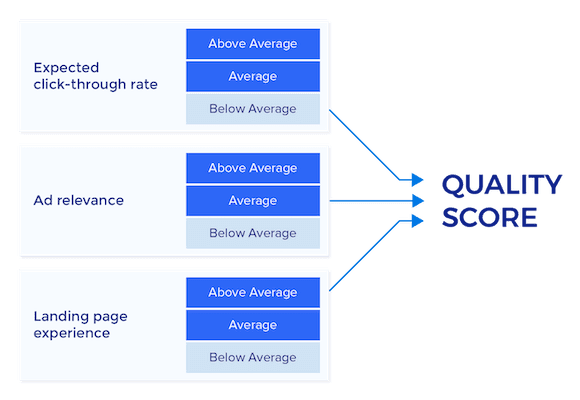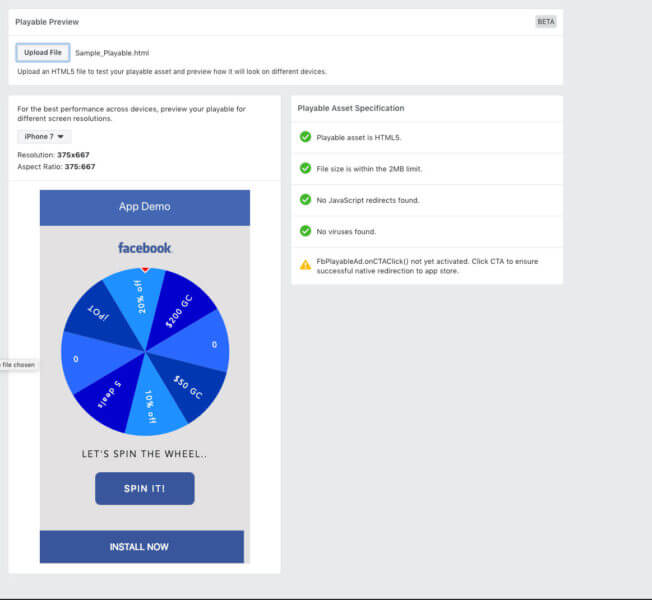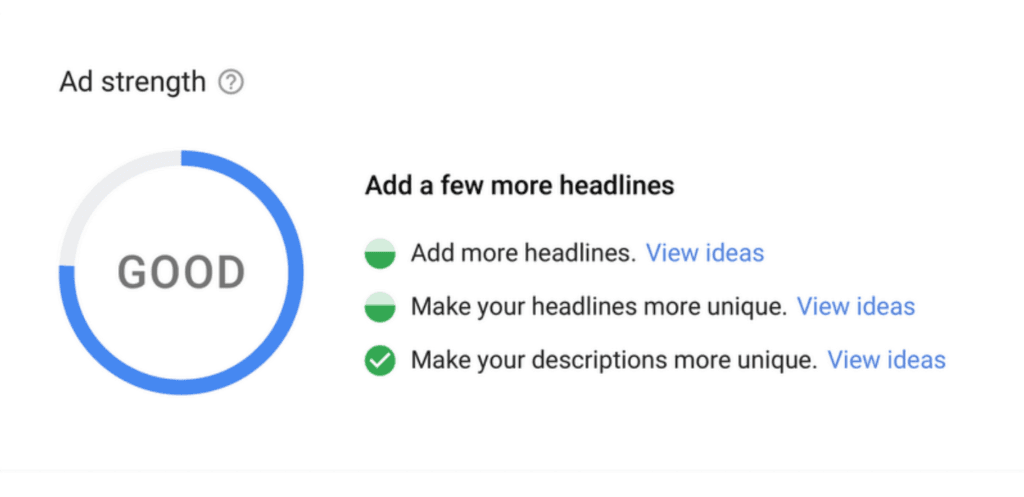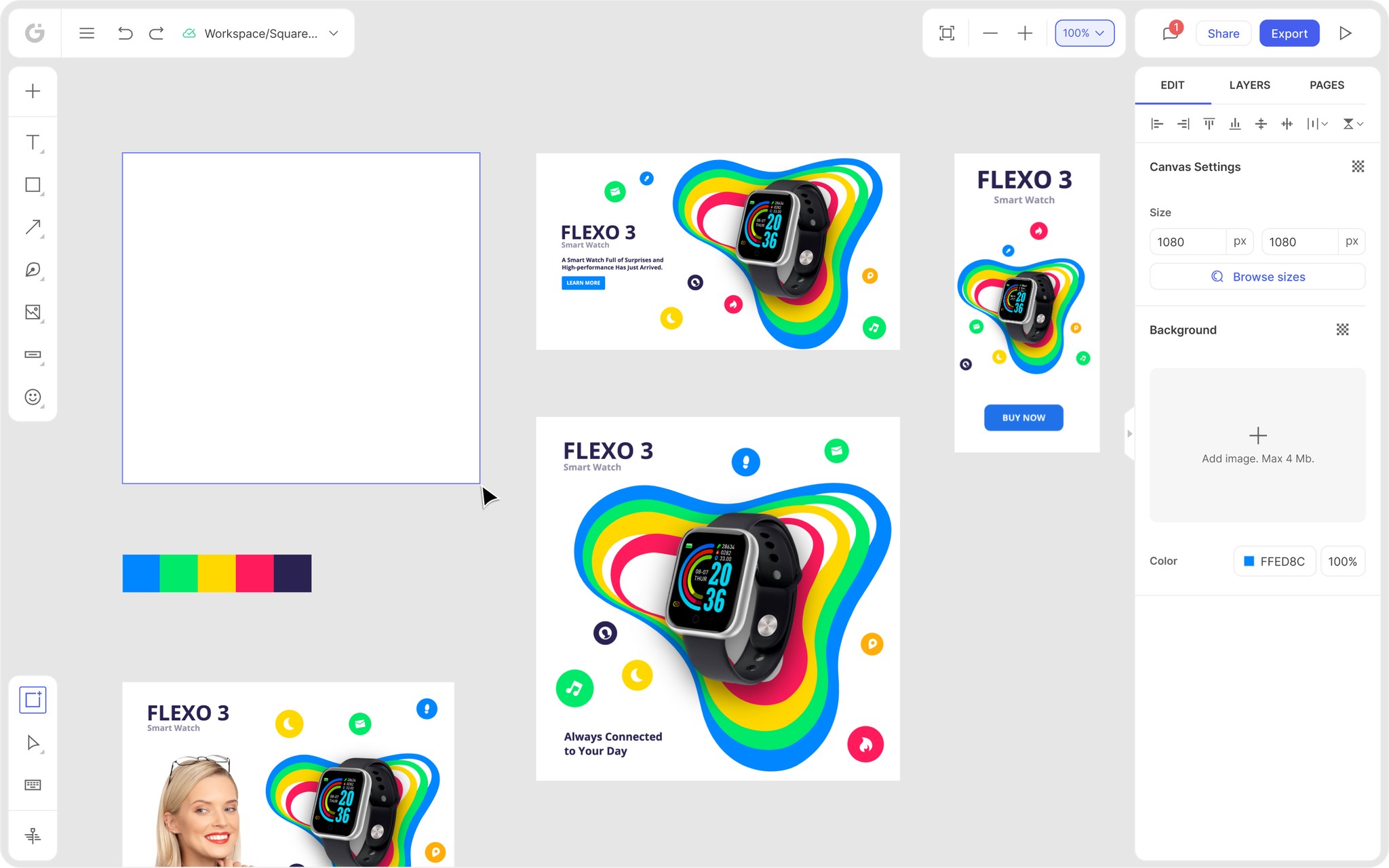Discover the essence of Amazon Storefront banners and their pivotal role in captivating potential customers. Learn the optimal size – 3000 pixels wide by 600 pixels tall – for seamless integration and stunning visual impact. Uncover expert tips for crafting compelling banners that reflect your brand identity and drive sales
Posted Nov 9, 2022
•
9 min read

Marketing, Google

Create beautiful marketing graphics at scale.
Google Responsive Display Ads: Explained
What Are Responsive Display Ads?
Google automatically creates responsive display ads using the assets that you provide them with. They automatically adjust the appearance, size, and format of your assets to fit the available ad spaces on the Google Display Network (GDN). Responsive display ads consist of the following elements:
Description
Business name
Short headline
Long headline
It may come with the following image elements:
Logo
Marketing video/image
Responsive display ads can be used for both regular and smart display campaigns.
Now, let’s move on to the six key benefits of Google Responsive Display Ads:
1. There’s no need to engage an outside designer –
For smaller companies that don’t have the resources to run standard display ads, responsive display ads are a great solution. Creating standard display ads can be difficult. You will need various images in various sizes. Smaller companies, more often, don’t have an in-house design team and they may be reluctant or unable to engage external designers.
However, with responsive display ads, you only need a logo and a couple of high-resolution images and You are good to go!
2. There’s no need to rely on your in-house design team –
For companies that have an in-house design team, creating the images needed for standard image ads can be a problem because it may not be the top priority for the design team. They can end up waiting for days, weeks, or even months to get the assets they need. Just like that, good opportunities are lost. In cases like these, responsive display ads can be a good temporary solution.
3. You might get better performance/ result –
There’s a possibility we might get better performance with responsive display ads than standard display ads. It doesn’t always happen, but it can happen.
4. You can utilize video assets –
We’re always on the lookout for new ways to deploy video assets as we’ve been getting good advertising traction with them. In addition to at least one landscape and square image, headlines, and descriptions, you can select up to five videos (max 30 seconds long) from your YouTube channel and display them in your responsive display ads.

5. Ads can be evaluated with a scorecard –
This scorecard gives feedback on how well your responsive display ads are set up before you go live. It provides you with an overall rating and suggestions to improve the strength of the ad. You’ll be able to find this feature in the Ads & Extensions window, just look for it in a column in your table of ads. It can be used to double-check your work.

6. A responsive display ad is better than having no ad at all –
When given the choice, a well-designed standard display ad is better than a responsive display ad because you have much more control over it. However, if the choice is between running a responsive display ad or running no ad at all, it is worth a shot.

How to create responsive display ads ?
Here’s the step by step process to create responsive display ads to get you up and running!
If you want to set up a new responsive display ad campaign on Google Ads, just head to the ‘Campaign’ present on your dashboard.
Then click the blue ‘+’ button to start a new campaign.
Start by selecting your campaign goals first. If you are unsure about which one to pick, simply hover your mouse over each campaign goal to reveal what networks they work with.
Once you are done selecting your campaign goal, select display again as your campaign type. You can select your campaign subtype here.
Select the standard display campaign selection, if you want general responsive ads. Then enter your landing page to get started.
On the campaign development screen, you will be able to go through a plethora of options to select and tweak from. From budgets to biddings and more.
Once you are done with modifying the settings for audiences, budgets, and more, it’s time to move on to, responsive ad creation. Just click on the blue ‘+’ icon on the bottom of the campaigns setting tab to start creating your responsive display ads:
Once you’ve clicked on this, you’ll see a few options.
From the list, click on ‘+ responsive display ad’.
This can get a little complicated if you’ve never used this format before. After clicking to create a new responsive display ad, you’ll be met with a bunch of elements to create.
Let’s break them down:
Visual assets:
The heart and soul of your responsive display ads is media / visual content. You can upload images of products you want to advertise, or logos of your company based on your goals right here.
For example, are you planning to sell direct products on these responsive ads, like clothes? If so, you just have to upload images of that said product! Or you can use logos if your goals are general brand awareness for your business. In addition to that, you can now use thirty-second videos (or less) to showcase both products or your brand.
Text / Ad Copy:
This is where you want to develop five sets of headlines and descriptions and remember the more you create, the better. Why? Because machine learning will use the various headlines and descriptions you write and test them with visual assets to find the best combination for you. So, this means the more you do now, the less you have to do later! Try to write the maximum amount so that you can get easy testing in early and more conversions.
Ad Previews:
This is a fantastic place to double-check your responsive display ads before sending them live. Based on what campaign you are running, you can preview your ads on the display network, YouTube, or Gmail. Make sure it looks good on both desktop and mobile phones. In the “Key ad formats” drop-down option, select all formats and ensure your images are scaling appropriately. When you select this option, it will cycle through various dimensions to show you a preview!

Ad Strength:
This is an easy way to improve your ad relevance, and consequently, your quality scores. Don’t take this step lightly because this can help you lower costs while generating more results. Add the maximum amount of headlines and images and ensure you tick every box on the ad strength tool before moving forward!

You did it! Pat yourself on the back and hit the ‘Create Campaign’ to make your responsive display ad live! What? All those steps sound too complicated? Don’t give up because we are here for you!
How to improve your Responsive Display Ads performance?
Here are a few tips on how to do maximize your responsive display ads :
Tip 1: Close-Up Images
A lot of responsive display ad formats are going to be small. People are browsing on mobile more than ever before, your creative assets should be up close and personal. For instance, you have two previews of a business, one with a zoomed-out picture and the other with a close-up image. Which one would you engage with?
You would probably not go for the first one unless you happen to be using a magnifying glass while browsing. Having zoomed out images that try to capture too much detract from their impact as the screen sizes on mobile are small for most users. People won’t be able to see them and creative assets are the biggest selling point. It hooks them in, so make sure you invest time and money into getting the right shots and logos you need that people can see.
Tip 2: Be aware of the headline and description combos
You have tons of room to write on responsive ads even until you can’t write anymore. The headlines and descriptions given can be customized with a fairly large amount of characters. However, be aware of how various text sections interact with one another. Google will combine multiple to form responsive display ads for you.
No matter what, headlines will always be shown on your responsive display ads which means that you will never see an image or a description. Therefore, after visual assets are added, headlines are your most important factor! So, you should put tons of time and effort into crafting compelling headlines that will get people to click.
Additionally, headlines can be shown without the description, depending on the ad slot you get. So, you should develop headlines that are compelling as well as tell what you want to say in just 30-90 characters. Depending on the ad slots you have, long headlines and descriptions can get cut off, so be sure to make your case early. Make sure to save the best for FIRST, as the end of your text can get cut off.
Conclusion: What are the key benefits of responsive display ads?
Google’s responsive display ads on the display network are the norm nowadays. They’re built to use Google’s machine learning technology to improve their reach and to reduce the need to create dozens of ad creatives for a single campaign.
You can simply upload a few pictures, add text blurbs, and have Google handle the process of picking appropriate ad slots. They are stronger than ever, with all the new updates. It’s the perfect time to jump on the responsive display ad’s bandwagon and reap the rewards before it gets too saturated.
Remember to follow our tips and you’ll be able to blow past the competition with exemplary responsive display ads in no-time!
Google Responsive Display Ads FAQs
1. How do Google display ads work?
Search ads show up when potential customers start looking on Google for what you can offer, whereas Display ads show up when people are visiting sites across the Google Display Network.
2. Where do Google display ads appear?
They can appear on the GDN. The Display Network is a collection of websites that includes specific Google websites such as Google Finance, Gmail, Blogger, and YouTube, that show ads. They also include sites on mobile and apps.
3. How much do display ads cost?
The average cost of an ad on Google Ads (AdWords) is $2.32 per click on the search network, meanwhile, the average cost per click of an ad on the Display Network is $0.58. Additionally, the average cost per action in a Google advertising search campaign is around $59.
4. Is It Time to Give Responsive Display Ads Another Look?
Due to habit, concerns about control, or skepticism over results, you might have stayed away from responsive display ads. But they can play a vital role in your Google Ads program.
Features
Explore templates
Alternatives
© 2024 Glorify App - All rights reserved














